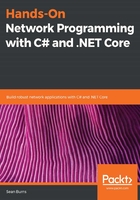
Conventions used
There are a number of text conventions used throughout this book.
CodeInText: Indicates code words in text, database table names, folder names, filenames, file extensions, pathnames, dummy URLs, user input, and Twitter handles. Here is an example: "Note the inclusion of the System.Net.Security namespace in our using directives. This is where the AuthenticationLevel enum is defined."
A block of code is set as follows:
var httpRequest = WebRequest.Create("http://test-domain.com");
var ftpRequest = WebRequest.Create("ftp://ftp.test-domain.com");
var fileRequest = WebRequest.Create("file://files.test-domain.com");
When we wish to draw your attention to a particular part of a code block, the relevant lines or items are set in bold:
if(!WebRequest.RegisterPrefix("cpf://", new CustomRequestCreator())) {
throw new WebException("Failure to register custom prefix protocol handler.");
}
Any command-line input or output is written as follows:
$ mkdir css
$ cd css
Bold: Indicates a new term, an important word, or words that you see on screen. For example, words in menus or dialog boxes appear in the text like this. Here is an example: "Select System info from the Administration panel."